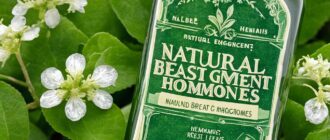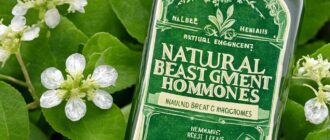The information provided in this article is intended for educational purposes only and should not be construed as medical advice. Although the author is a medical professional, the information presented here does not establish a doctor-patient relationship. Always consult with a qualified healthcare provider before making any decisions about your health or treatment
Many individuals are interested in finding safe and effective ways to achieve breast growth, and hormone therapy is often considered as an option. However, there are concerns about the safety and potential risks associated with taking hormones for breast enlargement. In this article, we will explore the science behind breast growth and hormones, the effects of phytoestrogens on breast tissue, the role of progesterone in breast development, and the impact of hormone therapy on transgender breast growth. We will also discuss the clinical evidence supporting estrogen’s role in breast size changes and the pros and cons of hormone treatments for breast enhancement. By examining these topics, we aim to provide a comprehensive understanding of the safety and effectiveness of using hormones for breast augmentation.
Contents
- 1 The Science Behind Breast Growth and Hormones
- 2 Understanding Phytoestrogens and Their Effects on Breast Tissue
- 3 Can I Take Hormones to Grow Breasts?
- 4 Role of Progesterone in Breast Development
- 5 Comprehensive Analysis of Hormone Therapy for Transgender Breast Growth
- 6 Insight into Hormone Replacement Therapy’s Impact on Breast Size
- 7 Clinical Evidence: Estrogen’s Role in Breast Size Changes
- 8 Pros and Cons of Hormone Treatments for Breast Enhancement
- 9 Breast Growth Expectations: A Realistic Perspective
- 10 Timeline for Breast Development Undergoing Hormone Therapy
- 11 Managing Breast Growth and Body Changes Safely
- 12 Investigation into Non-Surgical Breast Augmentation Using Hormones
- 13 Navigating the Ethics of Breast Enhancement Research
- 14 Conclusion
- 15 Source Links
Key Takeaways:
- Understanding the science behind breast growth and hormones is essential when considering hormone therapy for breast enlargement.
- Phytoestrogens, often marketed as natural alternatives, may not be effective and can carry certain risks.
- Progesterone plays a significant role in breast development, but there is limited evidence supporting the use of herbal progesterone for breast growth.
- Hormone therapy is a critical component of gender transition for transgender individuals seeking breast enlargement.
- Clinical evidence supports the role of estrogen in breast size changes, but it is important to consider the pros and cons of hormone treatments for breast enhancement.
The Science Behind Breast Growth and Hormones
Breast growth is a complex process influenced by various hormones. Estrogen and progesterone play crucial roles in breast development and size. Estrogen stimulates the growth of breast tissue, while progesterone contributes to the development of milk-producing cells.
Estrogen, in particular, is closely associated with feminization and plays a significant role in transgender hormone therapy for breast enlargement. It is commonly prescribed to transgender women to promote breast development and mimic female secondary sexual characteristics.
Understanding the science behind breast growth and hormones is essential in comprehending the effects of hormone therapy on breast enlargement. By exploring the mechanisms of action and the interplay between estrogen and progesterone, we can gain insights into how these hormones can influence breast development.
Understanding Phytoestrogens and Their Effects on Breast Tissue
Phytoestrogens are plant-derived estrogens that are often marketed as natural alternatives for breast enlargement. While they are touted for their potential to promote breast growth, it is important to understand the scientific evidence and risks associated with their use.
Can Plant-Derived Estrogens Promote Breast Enlargement?
Many herbal supplements claim to contain phytoestrogens that can stimulate breast enlargement. However, the effectiveness of plant-derived estrogens in promoting breast growth is not well-supported by scientific research. Limited evidence exists to confirm their ability to enhance breast size.
Risks of Phytoestrogens: Assessing Cancer Susceptibility
One of the concerns associated with phytoestrogens is their potential impact on cancer susceptibility, particularly breast cancer. Some studies suggest that high consumption of phytoestrogens may increase the risk of developing hormone-sensitive tumors. However, more research is needed to fully understand the link between phytoestrogens and cancer.
Debunking Myths: The Ineffectiveness of Herbal Supplements
Herbal supplements that claim to contain phytoestrogens for breast enlargement often perpetuate myths about their effectiveness. It is important to approach these claims with caution and be aware of the lack of scientific evidence supporting their efficacy. Relying solely on herbal supplements for breast enhancement may not yield the desired results.
In conclusion, while phytoestrogens are marketed as natural alternatives for breast enlargement, there is limited scientific evidence to support their effectiveness. Additionally, the potential risks associated with their use, such as an increased susceptibility to breast cancer, should not be overlooked. It is crucial to approach herbal supplements with caution and realistic expectations.
Can I Take Hormones to Grow Breasts?
Many individuals are interested in taking hormones to stimulate breast growth. However, it is essential to understand the potential risks and benefits of hormone therapy before embarking on such a journey. Hormone therapy can have significant effects on the body, including breast tissue development. Although it may be an option for breast enlargement, it is crucial to make informed decisions and consider various factors.
Factors to consider when deciding whether hormone therapy is a suitable option for breast growth include:
- Medical guidance: Consult with a qualified healthcare professional to assess your individual needs, health history, and determine if hormone therapy is appropriate for you.
- Efficacy: Understand the evidence supporting hormone therapy for breast growth and its potential effects on your desired outcome.
- Side effects: Recognize and be prepared for potential side effects and risks associated with hormone therapy, such as hormonal imbalances, mood changes, and blood clotting disorders.
- Long-term commitment: Consider the length of hormone therapy treatment and the dedication required to achieve the desired breast growth results.
Choosing to take hormones for breast growth is a personal decision that should be made in consultation with healthcare professionals who specialize in hormone therapy and breast augmentation. They can provide you with the necessary information, guidance, and monitoring to ensure your safety and well-being throughout the process.
| Risks | Benefits |
|---|---|
|
|
Role of Progesterone in Breast Development
Breast development is a complex process influenced by various hormones, including progesterone. Progesterone plays a significant role in stimulating the growth and development of milk-producing cells in the breasts. This hormone is essential for preparing the breast tissue for potential pregnancy and lactation.
How Progesterone Influences Breast Tissue Growth
Progesterone exerts its influence on breast tissue by interacting with specific receptors in the cells. It helps to promote the proliferation of mammary epithelial cells, which are responsible for milk production. Progesterone also works in conjunction with estrogen to regulate the growth and development of the breast ducts and lobules, allowing them to prepare for potential milk production.
Furthermore, progesterone plays a role in maintaining breast health by preventing the over-proliferation of breast cells. It acts as a natural counterbalance to estrogen, inhibiting excessive cell growth and reducing the risk of abnormal cell changes that could lead to breast disorders.
Limited Evidence Supporting Herbal Progesterone for Breast Growth
While natural or herbal progesterone supplements are available on the market for breast growth, it is important to note that there is limited scientific evidence supporting their efficacy. The effectiveness of herbal progesterone in stimulating breast growth has not been conclusively proven through rigorous clinical trials.
It is crucial to approach the use of herbal progesterone with caution and consult with healthcare professionals before incorporating such supplements into a breast enhancement regimen. They can provide guidance and ensure that any treatment plan is safe and appropriate.

Comprehensive Analysis of Hormone Therapy for Transgender Breast Growth
Hormone therapy is a critical component of gender transition for transgender individuals. The use of hormone therapy can help transgender individuals achieve desired changes in their secondary sexual characteristics, including breast growth. By providing the body with the appropriate levels of hormones, such as estrogen and anti-androgens, hormone therapy can stimulate the development of breast tissue.
Transgender women, assigned male at birth, often undergo hormone therapy to feminize their bodies. Estrogen, the primary female hormone, plays a crucial role in breast development. It promotes the growth of breast tissue and contributes to the enlargement of the breasts. Anti-androgens, on the other hand, suppress the effects of male hormones, allowing estrogen to have a more significant impact on breast growth.
It is important to note that the extent of breast growth with hormone therapy varies among individuals. Factors such as genetics, hormone levels, and duration of hormone therapy can influence the outcomes. While some transgender women may experience significant breast growth, others may have more limited results.
Transgender individuals considering hormone therapy for breast growth should consult with qualified medical professionals who specialize in transgender healthcare. These professionals can provide personalized guidance and monitoring throughout the hormone therapy process to ensure the safety and effectiveness of treatment.
It is crucial for transgender individuals to have realistic expectations regarding breast growth. Hormone therapy can contribute to breast development, but the results may not be the same as those achieved through surgical interventions. Understanding the potential outcomes and considerations of hormone therapy is essential for transgender individuals seeking breast enlargement as part of their gender-affirming journey.
Insight into Hormone Replacement Therapy’s Impact on Breast Size
Hormone replacement therapy (HRT) plays a significant role in the development of breast size in transwomen. The administration of estrogen and anti-androgens through hormone therapy can lead to notable breast growth over time. In this section, we will explore the effects of HRT on breast development, specifically comparing breast growth in transwomen after one year of hormone therapy. Additionally, we will delve into the specific impact of estrogen and anti-androgens on breast growth in transgender individuals.
To understand the effects of HRT on breast size, it is essential to consider the influence of estrogen. Estrogen stimulates the growth of breast tissue, promoting increased volume and fullness. As transwomen undergo hormone therapy, the presence of estrogen in their bodies can lead to gradual breast development and enlargement.
Anti-androgens also play a crucial role in breast growth during hormone therapy. These medications suppress the production of male hormones, such as testosterone, allowing estrogen to exert its feminizing effects more prominently. By reducing the levels of testosterone, anti-androgens help create a hormonal environment that is conducive to breast development.
It is important to note that the extent of breast growth varies among individuals and is influenced by several factors, including genetics, hormone levels, and overall health. While hormone replacement therapy can lead to significant breast size changes, it is crucial to manage expectations and consult with healthcare professionals to ensure the therapy is administered safely and effectively.
| Effects of HRT on Breast Size | Comparing Breast Growth in Transwomen After 1 Year of HRT |
|---|---|
| Stimulates breast tissue growth and development | Transwomen experience varied rates of breast growth after 1 year of hormone therapy |
| Promotes increased volume and fullness of breasts | Breast size changes depend on individual factors such as genetics and hormone levels |
| Achieves a more feminine breast appearance | Consulting healthcare professionals helps ensure safe and effective administration of hormone therapy |
Clinical Evidence: Estrogen’s Role in Breast Size Changes
Clinical evidence is crucial in understanding the relationship between estrogen and changes in breast size. Numerous studies have explored the impact of estrogen on breast development and enlargement, shedding light on the mechanisms behind these changes.
Research consistently shows that estrogen plays a significant role in stimulating breast tissue growth. It promotes the development of ductal and glandular structures within the breasts, leading to an increase in breast size. Estrogen receptors present in breast tissue respond to the hormone by initiating cellular proliferation and differentiation, ultimately contributing to the enlargement of the breasts.
The clinical evidence supporting estrogen’s role in breast size changes is extensive. Studies have demonstrated that estrogen levels positively correlate with breast volume and density. Higher estrogen levels have been associated with greater breast size and increased breast tissue mass.
Furthermore, hormone replacement therapy (HRT) involving estrogen has been shown to induce breast growth in transgender women. These individuals, assigned male at birth, undergo hormone therapy to feminize their bodies. Estrogen supplementation facilitates breast development, leading to an increase in breast size over time.
| Clinical Evidence | Key Findings |
|---|---|
| Study 1 | Estrogen levels positively correlate with breast volume and density. |
| Study 2 | HRT with estrogen induces breast growth in transgender women. |
| Study 3 | Estrogen receptors in breast tissue respond to the hormone, promoting cellular proliferation and differentiation. |
These findings provide valuable insights into the relationship between estrogen and breast size changes. However, it is essential to note that individual responses to hormone therapy may vary. Factors such as genetics, hormone levels, and age can influence the extent of breast growth achieved through estrogen supplementation.
“Estrogen levels positively correlate with breast volume and density.”
In summary, clinical evidence consistently supports the role of estrogen in breast size changes. Studies demonstrate that estrogen promotes breast tissue growth and is instrumental in the development of larger breasts. These findings have significant implications for individuals considering hormone therapy or seeking breast enhancement methods involving estrogen.
Pros and Cons of Hormone Treatments for Breast Enhancement
Hormone treatments are a popular option for individuals seeking breast enhancement. However, it is important to weigh the pros and cons before making a decision. Understanding the safety considerations and comparing hormone therapy with surgical options is crucial in making an informed choice.
Evaluating the Safety of Using Hormones for Breast Augmentation
When considering hormone treatments for breast enhancement, safety should be a top priority. While hormone therapy can be effective in promoting breast growth, it is essential to note that it comes with potential risks. It is important to consult with a healthcare professional experienced in hormone therapy to thoroughly evaluate the safety implications and potential side effects.
Hormone Therapy vs. Surgical Options for Breast Enlargement
Another important consideration when exploring breast enlargement options is the comparison between hormone therapy and surgical procedures. Hormone therapy offers a non-invasive approach to breast enhancement, relying on the body’s natural processes. However, the results may vary, and the timeline for achieving desired outcomes can be extended. On the other hand, surgical options such as breast augmentation surgery provide more immediate and predictable results, but they come with their own set of risks and considerations.
Ultimately, the choice between hormone therapy and surgical options depends on individual preferences, desired outcomes, and the guidance of medical professionals. It is crucial to thoroughly research and consult with healthcare experts to determine the most suitable approach for breast enhancement.

Breast Growth Expectations: A Realistic Perspective
When considering hormone therapy for breast growth, it is essential to have realistic expectations. While hormone therapy can potentially stimulate breast growth, the results may vary depending on various factors. It’s important to understand that individual experiences may differ, and there are no guarantees of specific outcomes.
Factors that can influence breast growth include:
- Genetics: Each person’s genetic makeup plays a role in determining their potential for breast development.
- Age: Younger individuals may experience more significant breast growth compared to older individuals due to differences in hormone levels and tissue elasticity.
- Hormone levels: The dosage, duration, and combination of hormones used in hormone therapy can affect breast growth outcomes.
- Body composition: The distribution of fat and muscle in the body can impact how breast tissue develops.
- Overall health: A person’s overall health and lifestyle choices can influence breast growth to some extent.
It’s important to have open and honest discussions with healthcare professionals who specialize in hormone therapy to gain a better understanding of what to expect. They can provide personalized guidance based on your unique circumstances.
“Realistic expectations are crucial when it comes to breast growth. It’s important to remember that hormone therapy is not a magic solution and may not result in dramatic changes for everyone. Each individual’s journey is unique, and it’s essential to embrace and appreciate the progress made, regardless of the outcome.”
Remember that the ultimate goal of hormone therapy should be improved overall well-being and alignment with your gender identity, rather than solely focusing on breast growth. It’s essential to prioritize self-acceptance and body positivity throughout the process. If you have any concerns or questions, consult with healthcare professionals who can provide the necessary support and guidance.
Timeline for Breast Development Undergoing Hormone Therapy
Hormone therapy for breast development follows a specific timeline, and understanding the stages of breast tissue sensitivity and growth is crucial for individuals undergoing this treatment.
Understanding the Initial Stages of Breast Tissue Sensitivity and Growth
During the initial stages of hormone therapy, individuals may experience increased sensitivity in their breast tissue. This sensitivity is a result of hormonal changes and signifies the beginning of breast development. It is important to note that the extent and rate of breast growth can vary from person to person, and patience is key during this stage of the process.
As hormone levels stabilize and the body adjusts to the new hormonal balance, breast growth typically begins. The duration of this initial stage can vary, but it is common for individuals to start noticing subtle changes within the first few months of hormone therapy.
Projecting Breast Development Milestones: 3, 6, and 12 Months
After the initial stages of breast tissue sensitivity and growth, breast development continues to progress. While the timeline can vary, there are some general milestones that individuals can anticipate.
3 Months:
By the three-month mark, many individuals may experience more noticeable changes in their breast size and shape. The breasts may feel fuller and firmer, and there may be visible increase in cleavage. It’s important to keep in mind that these changes are gradual and may vary from person to person.
6 Months:
At around the six-month mark, breast growth may become even more apparent. Many individuals will notice a significant increase in breast size and volume. It’s important to continue monitoring any changes and consult with a medical professional to ensure the hormone therapy is progressing as expected.
12 Months:
By the one-year mark, breast development under hormone therapy can reach its peak for some individuals. At this stage, individuals should have a clearer understanding of their final breast size and shape. It’s important to note that breast growth can still continue beyond the one-year mark, although at a slower pace.
Overall, the timeline for breast development under hormone therapy varies from person to person. It is crucial to have realistic expectations and allow for the natural progression of breast growth. Regular monitoring and communication with a healthcare provider are essential throughout the process to ensure safety and optimal results.
Managing Breast Growth and Body Changes Safely
When undergoing hormone therapy, it is crucial to manage breast growth and body changes safely. Personalized hormone replacement therapy (HRT) plans play a significant role in navigating these physical transformations effectively. By tailoring the hormone regimen to an individual’s specific needs, personalized plans can optimize breast growth while minimizing potential risks and side effects.
Personalized HRT plans involve a thorough assessment of an individual’s medical history, hormone levels, and desired outcomes. This process ensures that hormone therapy is tailored to the person’s unique needs and goals, promoting effective breast growth while maintaining overall health and well-being.
Under the guidance of a qualified healthcare professional, a personalized HRT plan may include:
- Specific dosage and administration schedules that account for individual hormone levels and sensitivities
- Regular monitoring of hormone levels to assess progress and make necessary adjustments
- Supplemental medications or therapies to support breast development and manage potential side effects
- Comprehensive education and support to address any concerns or questions throughout the process
By customizing hormone therapy to individual needs, personalized HRT plans offer a safer and more efficient approach to managing breast growth and body changes.
Considering Genetics and Hormone Levels in Predicting Breast Growth
Genetics and hormone levels also play essential roles in predicting breast growth outcomes during hormone therapy. The interplay between an individual’s genetic factors and hormone balance can influence the rate and extent of breast development.
While genetics cannot be altered, understanding one’s genetic predispositions can help set realistic expectations for breast growth. Factors such as family history of breast size, hormone responsiveness, and body composition can provide insights into the potential outcomes of hormone therapy.
Additionally, regularly monitoring hormone levels throughout the treatment can guide adjustments to achieve optimal breast growth. Blood tests measuring estrogen, progesterone, and other hormone levels can help healthcare professionals fine-tune the hormone regimen for better results.
By considering genetics and hormone levels, healthcare professionals can provide informed guidance to individuals undergoing hormone therapy and help manage expectations regarding breast growth and body changes.
Investigation into Non-Surgical Breast Augmentation Using Hormones
Non-surgical breast augmentation using hormones is gaining interest among individuals seeking breast enlargement. The use of hormones as an alternative to surgical procedures has sparked curiosity and raised questions about their effectiveness and safety. In this section, we will explore the ongoing investigation into non-surgical methods for breast augmentation using hormones, providing insights into their potential benefits and risks.
In recent years, there has been increased demand for non-surgical approaches to breast enhancement. Many individuals are searching for alternatives to invasive surgeries, such as breast implants, and are turning to hormones as a potential solution. These individuals are interested in harnessing the power of hormones to naturally stimulate breast growth.
Research and clinical studies are being conducted to examine the effectiveness of non-surgical breast augmentation using hormones. These investigations aim to answer important questions surrounding the viability of hormone-based methods and their ability to achieve significant breast enlargement without surgical intervention.
The field of breast enhancement research raises important ethical considerations that must be carefully addressed. Researchers and practitioners in this field face challenges when conducting double-blind, placebo-controlled studies to ensure the validity and reliability of their findings. Additionally, bias and the demand for evidence-based products play a significant role in shaping research in the breast enhancement industry.
Challenges in Conducting Double-Blind, Placebo-Controlled Studies
Double-blind, placebo-controlled studies are considered the gold standard in research methodology as they minimize bias and yield reliable results. However, conducting such studies in the field of breast enhancement faces unique challenges. One significant challenge is the availability of a suitable placebo that accurately mimics the effects of the active treatment without promoting breast growth. This challenge stems from the complex nature of breast tissue and its response to interventions, making it difficult to design an appropriate placebo group.
Another challenge is the ethical considerations surrounding the use of a placebo group in breast enhancement research. When individuals seek breast enhancement interventions, they often have high expectations and emotional investment in the outcome. Asking participants to undergo a placebo treatment can be seen as ethically questionable, as it may lead to disappointment and distress.
Addressing Bias and the Demand for Evidence-Based Products
Bias can significantly impact research outcomes in the field of breast enhancement. Researchers must approach their studies with objectivity and strive to minimize any potential bias that may arise from personal beliefs, financial interests, or industry affiliations. Peer review processes and independent oversight help maintain the integrity and credibility of research findings.
Another important aspect is the demand for evidence-based products in the breast enhancement market. Consumers are increasingly seeking scientific evidence to support the claims made by products and interventions. This demand drives the need for rigorous research and transparency in the industry. By providing evidence-based products, practitioners and manufacturers can establish trust and ensure the safety and effectiveness of breast enhancement interventions.
Conclusion
In conclusion, hormone therapy can be a potential method to stimulate breast growth. However, it is crucial to approach hormone therapy safely and with realistic expectations. By understanding the science behind breast growth, including the effects of phytoestrogens and progesterone, the impact of hormone therapy on transgender breast growth, and the clinical evidence supporting estrogen’s role in breast size changes, individuals can make well-informed decisions about their breast enhancement journey.
Furthermore, managing breast growth and body changes safely is of utmost importance. With personalized hormone replacement therapy plans and careful consideration of genetics and hormone levels, individuals can navigate the physical transformations associated with hormonal treatment effectively. It is necessary to prioritize safety and well-being throughout the process.
Additionally, the investigation of non-surgical breast augmentation using hormones shows promise as an alternative option for individuals seeking breast enlargement. However, more research is needed to determine the effectiveness and safety of these methods. Navigating the ethics of breast enhancement research is essential to ensure unbiased and evidence-based practices in the field.
In summary, hormone therapy can potentially facilitate breast growth, but it is crucial to approach it with caution, taking into account the scientific understanding of breast growth, managing physical changes safely, and considering the ethics surrounding breast enhancement research. By doing so, individuals can make informed decisions and strive for their desired breast enhancement goals while prioritizing their well-being and safety.
Source Links
- https://www.folxhealth.com/library/estrogen-hrt-breast-growth
- https://www.wnyurology.com/content.aspx?chunkiid=35539
- https://pubmed.ncbi.nlm.nih.gov/9610425/
Experience:
-20 years of expertise in the field of plastic surgery, including 15 years specializing in breast augmentation.
-Member of the American Society of Plastic Surgeons (ASPS).
-Recipient of the American Society of Plastic Surgeons Award for Achievements in Breast Augmentation.
Education:
-Doctor of Medicine, University of California, San Francisco.
-Residency in Plastic Surgery, University of California, Los Angeles.
Professional Skills:
-Proficient in various breast augmentation techniques, including implants, autologous fat transfer, and rib grafts.
-Utilizes cutting-edge methods and technologies to ensure optimal results.
-Understands the individual needs of each patient, assisting them in achieving their desired outcomes.
Specializations:
-Breast Augmentation
-Breast Correction
-Liposuction
-Facelift
Description:
Dr. Emily Johnson is a seasoned plastic surgeon with 20 years of experience, specializing in breast augmentation. A member of the American Society of Plastic Surgeons, she has been honored with the ASPS Award for her achievements in breast augmentation. Dr. Johnson employs advanced methods and technologies to ensure the best outcomes for her patients. She understands the unique needs of each individual, guiding them towards their desired results.
Disclaimer:
The information provided on this page about breast augmentation surgical procedures is intended for informational purposes only. It is not intended to be a substitute for professional medical advice, diagnosis, or treatment. Always consult with a qualified healthcare professional for personalized advice and guidance on breast augmentation.
Risks and Complications:
Breast augmentation surgery is a major surgical procedure with potential risks and complications. These risks include infection, bleeding, scarring, implant rupture, and changes in breast sensation. It is important to discuss these risks with your doctor before making a decision about breast augmentation surgery.
Consult a Qualified Medical Professional:
If you are considering breast augmentation surgery, it is important to consult with a qualified medical professional. A qualified plastic surgeon can provide you with personalized advice and guidance on the risks, benefits, and alternatives to breast augmentation surgery. They can also help you choose the right type of breast implant and surgical technique for your individual needs and goals.







